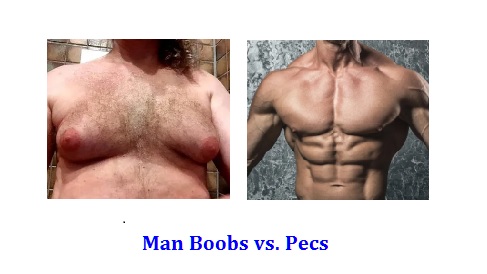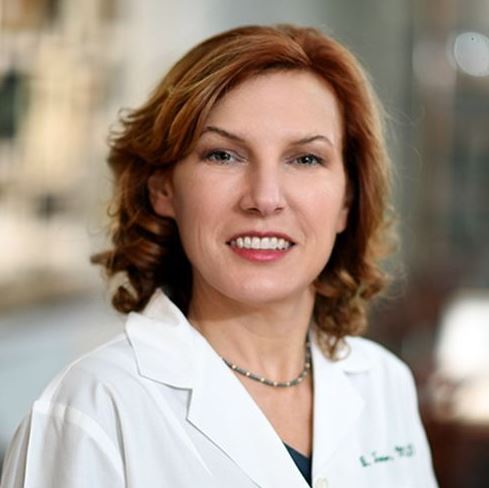Many people use the terms man boobs and pecs interchangeably to describe the chest area of men. However, these terms represent two completely different anatomical features with distinct characteristics, causes, and treatments.
The difference between man boobs vs pecs is that man boobs – gynecomastia – refer to the enlargement of breast tissue in men, while pecs – pectoralis muscles – are the muscles that make up the chest.
Understanding the difference between man boobs and pecs is crucial. It allows you as a man to identify potential medical issues and develop a targeted workout and diet plan. You can then use that information and strategy to achieve your desired physique.
In this article, I will explain the differences between gynecomastia and pecs, including their definitions, characteristics, causes, and treatments, as well as the role of exercise and diet in developing and maintaining a toned chest.
Differences between Man Boobs vs Pecs

The difference between man boobs and pecs is significant in terms of both appearance and underlying causes.
Appearance
Man boobs, also known as gynecomastia, appear as enlarged breast tissue in males, resulting in a more feminine-looking chest. On the other hand, Pecs are well-defined and developed muscles in the chest, giving a more masculine appearance.
Causes
The causes of man boobs can include hormonal imbalances, certain medications, and excess body fat. In contrast, pecs are developed through targeted chest exercises and a healthy diet.
Treatment
Men with gynecomastia may require medical treatment, such as hormone therapy or surgery, to reduce the size of the breast tissue.
Exercise and Diet
Exercise and diet are crucial in both the prevention and treatment of man boobs and the development of pecs. In addition, cardio and weight training can help reduce body fat and increase muscle mass, leading to a more defined and toned chest.
A healthy diet with adequate protein can also support muscle growth and overall health. In contrast, a poor diet and lack of exercise can contribute to excess body fat and the development of man boobs.
Man Boobs Causes and Characteristics
Causes of Man Boobs
Man boobs, or gynecomastia, is a medical condition characterized by the enlargement of breast tissue in men. An imbalance of hormones, particularly an increase in estrogen levels and a decrease in testosterone levels, are the main causes of gynecomastia.
Other potential causes of man boobs include excessive body fat, certain medications such as anti-androgens, anabolic steroids, and some antidepressants, as well as medical conditions such as hypogonadism, hyperthyroidism, and liver or kidney disease.
Man boobs are not a serious medical condition, but they can cause significant psychological distress and self-esteem issues and hinder a person’s quality of life. Treatment may involve lifestyle changes, medication, or surgery, depending on the severity of the condition.
Characteristics of Man Boobs
Firstly, man boobs often result in an excessive growth of breast tissue, leading to an enlargement of the chest area. The breast tissue can range from small, firm lumps to larger, softer mounds. They can be visible when you wear a shirt or other clothing.
This growth can occur in one or both breasts, and the degree of growth can vary from mild to severe.
Secondly, man boobs can result in a soft and saggy appearance of the chest area. The breast tissue may feel soft to the touch, and the skin around the breast may appear to sag or droop. That can cause your chest to take on a more feminine appearance.
For many men who suffer from the condition, it can lead to significant emotional distress and self-esteem issues for men.
Lastly, man boobs can lead to a lack of muscle definition in the chest area. That is because the breast tissue growth can obscure the underlying pectoralis muscles. Moreover, that makes it difficult to achieve a toned, muscular chest through exercise alone.
In some cases, the breast tissue may even appear to push the pectoralis muscles outward. That leads to an asymmetrical appearance of the chest. This lack of muscle definition can frustrate you, even when you are in good physical shape.
It can also contribute to feelings of embarrassment and shame about your body.
How to Treatment Gynecomastia
The treatment of gynecomastia, or man boobs, depends on the severity and underlying causes.
Lifestyle Changes
In mild cases, you can use lifestyle changes to reshape the appearance of breast tissue. The lifestyle changes include weight loss, regular exercise, and avoiding drugs or medications that can contribute to hormonal imbalances.
Targeted Chest Exercises
Targeted chest exercises, such as push-ups, chest presses, and dumbbell flys, can help to increase muscle tone and reduce the appearance of breast tissue. However, lifestyle changes alone may not eliminate breast tissue in more severe cases.
Man Boobs Medications
You can also use medications to treat gynecomastia. They work by either blocking the effects of estrogen in the body or reducing the amount of estrogen produced. The most commonly used medications include tamoxifen, raloxifene, and aromatase inhibitors.
These medications can effectively reduce the size of breast tissue in some men. However, they may cause side effects such as hot flashes, nausea, and mood changes. In addition, these medications can only treat gynecomastia if the cause is excess estrogen.
Gynecomastia Surgery
Gynecomastia surgery is often the most effective treatment. It treats severe breast tissue growth that does not respond to lifestyle changes or medications. The two most common surgical procedures are liposuction and mastectomy.
Liposuction involves the removal of excess fat from the chest area, while mastectomy involves the removal of breast tissue. Sometimes, your surgeon may use both procedures to achieve the desired results.
Surgical treatment of gynecomastia is safe, but it does carry some risks, such as infection, bleeding, and scarring. Therefore, it is important to discuss the risks and benefits of surgery with a qualified healthcare professional before making a decision.
Some nonsurgical gynecomastia treatments use a triple-action approach. They combine natural ingredients to restore hormonal balance, exercises to help tone chest muscles, and a healthy diet to stop weight gain. A good example of such treatment is Gynetrix.
What are Pecs?
Pecs, short for pectoralis muscles, are a pair of large muscles that make up the chest. They are located in the upper front of the torso and are responsible for moving the arms and shoulders.
The pectoralis muscles are composed of two major parts: the pectoralis major and the pectoralis minor. The pectoralis major is the larger of the two muscles and is responsible for most of the movement of the shoulder joint.
The Pectoralis major consists of the clavicular head and the sternal head. A clavicular head is located near the collarbone and enables you to lift the arm forward. And a sternal head is located near the sternum and helps you pull the arm down and inward.
The pectoralis minor is located beneath the pectoralis major and stabilizes the scapula.
These pectoralis muscles are an important part of the upper body musculature and contribute to overall strength and physical fitness.
Pecs Characteristics
Pecs are highly desirable muscles for many men due to their well-defined and toned appearance. Unlike man boobs, pecs are composed of muscle tissue, not breast tissue, giving them a firm and toned appearance.
The pectoralis major and minor muscles are both well-defined and contribute to a well-defined chest, shoulder, and upper arm musculature. Pecs can be developed through targeted exercise, such as chest presses, dumbbell flys, and push-ups.
The firm and toned appearance of pecs is due to their muscle tissue composition. This relatively dense muscle tissue contributes to a toned appearance that does not sag. As a result, pecs can give you an overall youthful appearance and improved self-confidence.
Additionally, well-toned pecs can improve posture and contribute to overall upper-body strength, making daily activities easier and reducing the risk of injury.
A key characteristic of well-developed pecs is their symmetrical appearance. Unlike man boobs, which can cause an asymmetrical appearance of the chest, well-developed pecs are symmetrical and contribute to a balanced overall physique.
How to Develop Pecs
You can achieve great pecs through a combination of exercises, diet, rest, and recovery.
First, exercises such as bench presses, push-ups, and flys target the pectoral muscles, and you should perform them consistently and with proper form.
Second, a well-rounded diet with sufficient protein and calories is necessary to fuel muscle growth and recovery.
Third, allowing for proper rest and recovery time is crucial for muscle repair and growth, as well as preventing injury.
That includes getting enough sleep, taking rest days, and incorporating stretching and foam rolling into your routine. By incorporating these three elements into your chest training, you can achieve optimal results and improve overall chest strength and definition.
Man Boobs and Pecs – How to Transition to Pecs
The one similarity between man boobs vs pecs is they are both located in the chest area. However, their appearance, causes, and treatment options are fundamentally different.
For instance, man boobs are undesirable, while pecs give you a youthful and athletic appearance.
Regular exercise and a healthy diet can help prevent the development of man boobs. Moreover, they can help you develop a more masculine-looking chest with defined and toned pecs.
